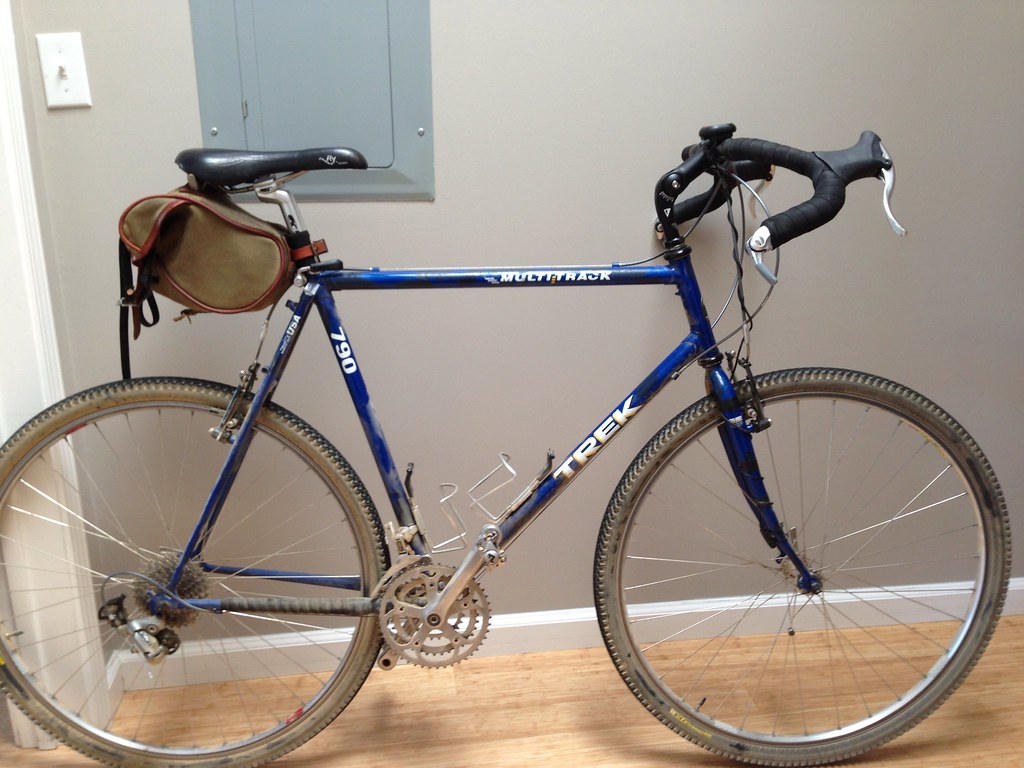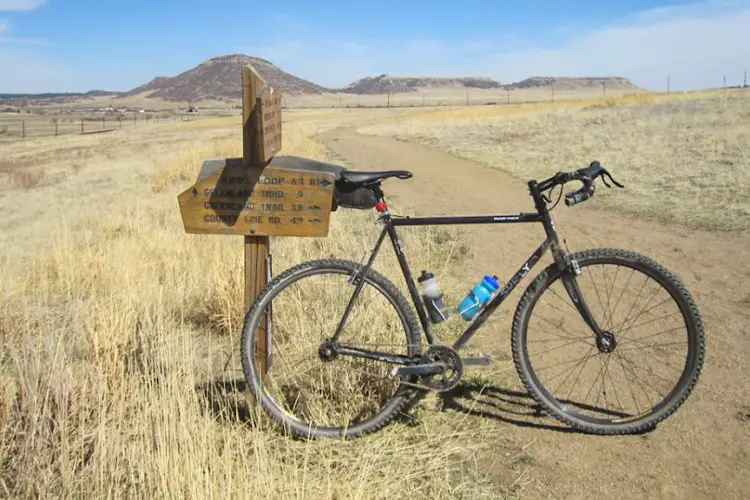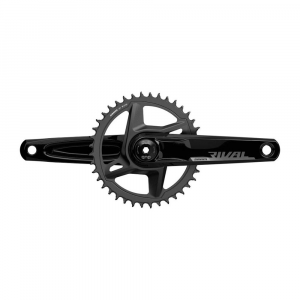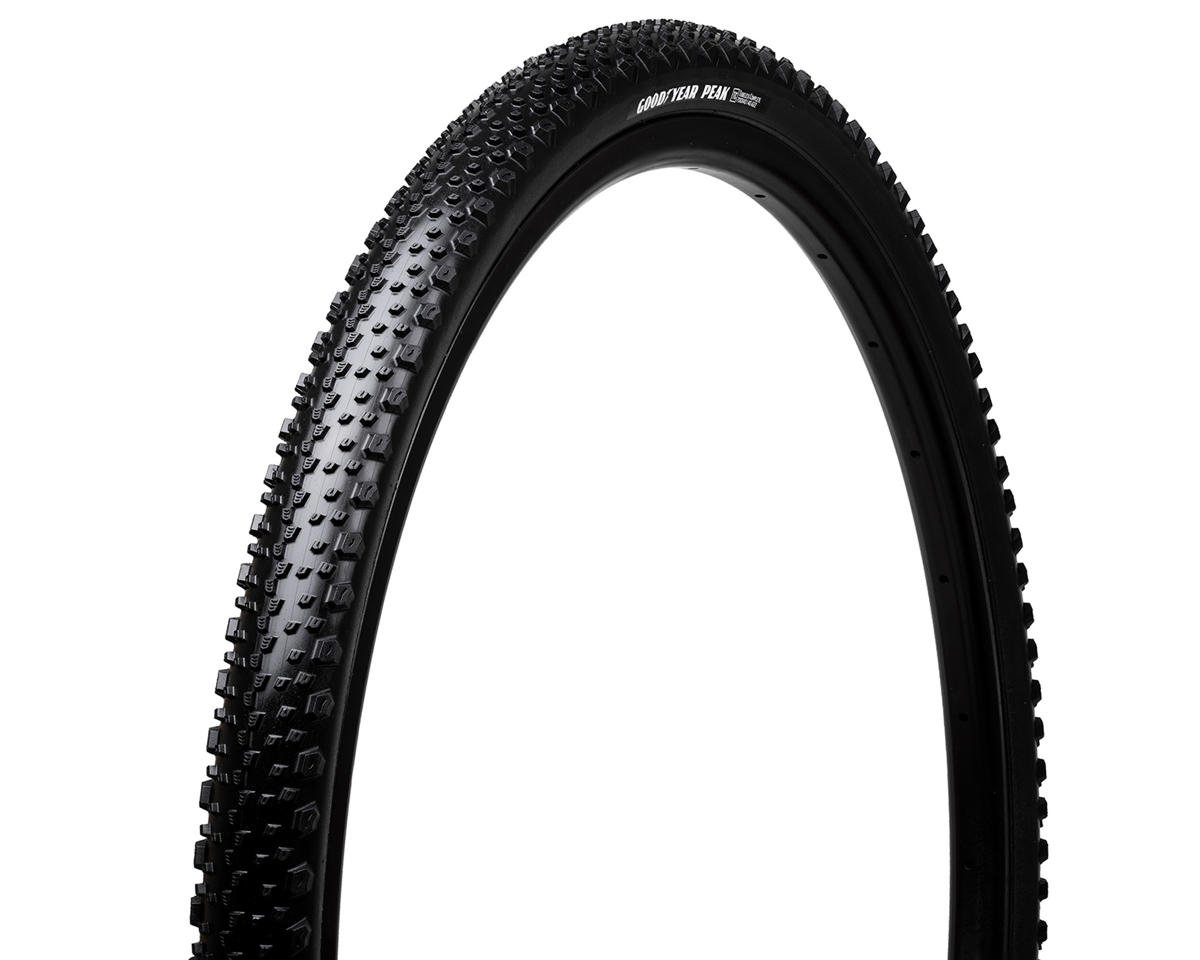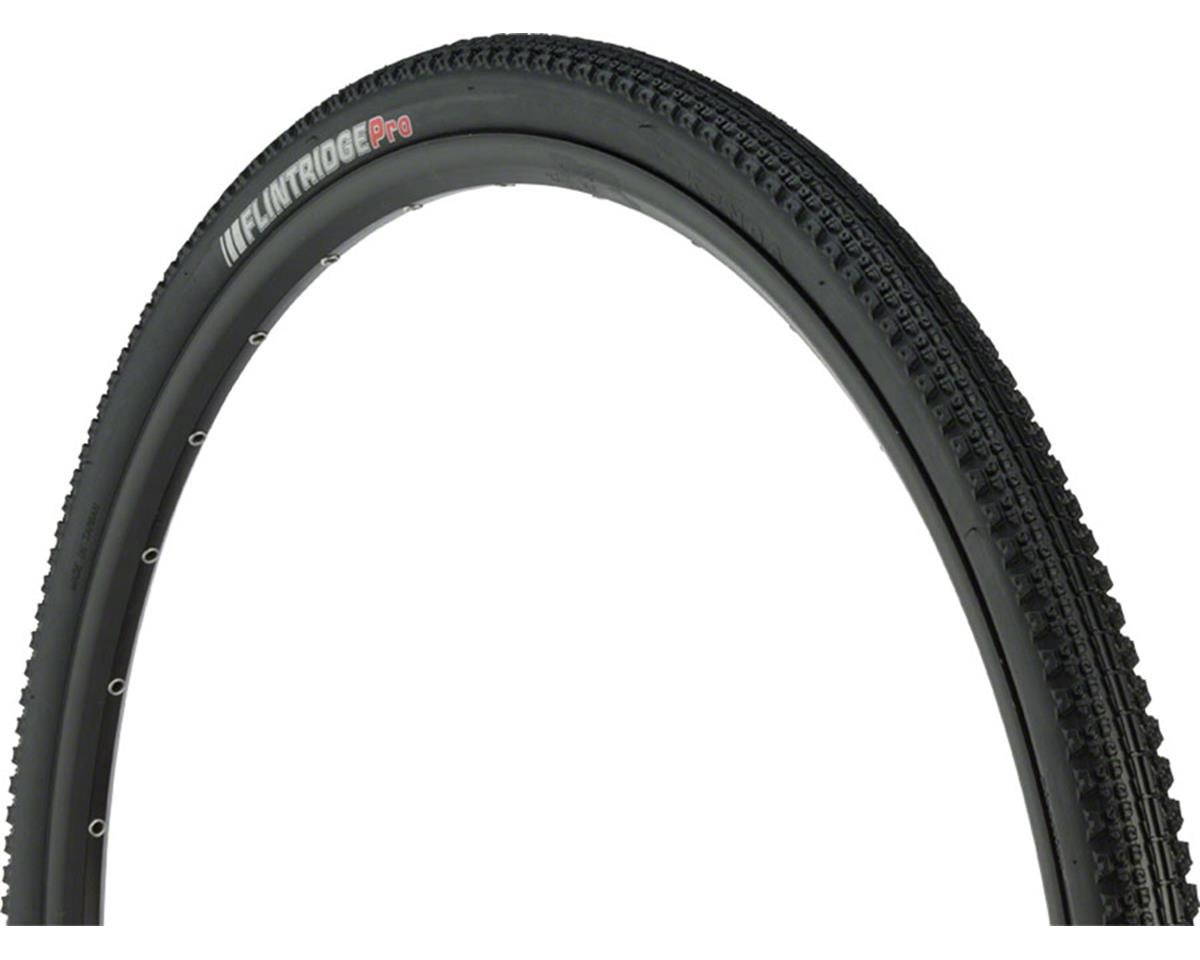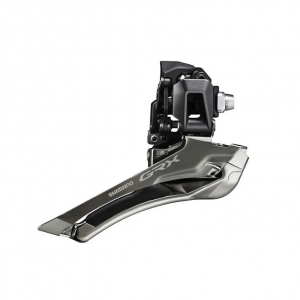A history major in college, Jon Severson of Colorado Springs has a post-graduate history project that is a little more interesting than anything he did during his studies. Severson maintains the Monster Cross News Facebook Page, which documents and maintains the historical legacy of monster cross bikes.
Many of us throw the term around loosely whenever we see fatter tires and drop bars, but for Severson, when talking about monster cross, it is worth starting with a definition. Severson’s page gives this description:
Monster cross is a bike designed to fill the gap between a cyclocross bike and a mountain bike. A true do-it-all bike that rides singletrack, pavement and gravel well. Key features are rather simple: tires between 38-45mm tires and dirt drop handlebars.
According to Severson, Matt Chester started the monster cross movement in the early 2000s to create a bike that is adept at all kinds of riding. “Matt Chester wanted to create a bike that does it all well,” he said. The straightforward approach appealed to Severson, “The simplicity and the idea of one bike that truly could do a little of everything really appealed to me.”
Cyclocross Magazine has profiled a number of Monster Cross bikes, especially custom builds seen at events such as last year’s Paul Camp. We wanted to learn more about monster cross—and maybe get some tips for doing our own DIY builds—so we reached out to Severson to learn more about his historical preservation project, his thoughts on DIY builds and what he rides himself.
Interview with Jon Severson of Monster Cross News
Cyclocross Magazine: You started and run the Monster Cross News Facebook Page. What got you passionate about monster cross?
Jon Severson: I started that page over 10 years ago for fun because there were no resources available, and I felt like people were misrepresenting monster cross. I followed Matt Chester as he fine tuned the concept in 2002-2003. The simplicity and the idea of one bike that truly could do a little of everything really appealed to me. It’s kind of why I bought a mountain bike back in 1989; they were more do-it-all machines then versus the just off-road bikes they are now (which I love, by the way).
My monster cross bike is truly the bike I ride the most day in and day out. I ride singletrack and gravel on it, ride it down to the local distillery to drink whiskey and use it to head downtown to my favorite diner for breakfast. Roll up the canyon to my coffee spot. Go get groceries. Does it all.
You won’t win an enduro or any other race on it, but it’s the one bike you just ride and don’t worry about. The only thing left to improve is you.
CXM: How do you define monster cross? Is it any different from throwing drop bars on a mountain bike or fat tires on a cyclocross bike?
JS: I don’t necessarily think it’s right to say “how I define monster cross,” since it’s not my creation. I’m just a historian preserving a small part of history I don’t want to see fade away.
Matt Chester wanted to create a bike that does it all well. His vision was a bike designed around dirt drops, which give you better off-road handling than normal road-style bars yet still have enough positions for long rides, and 42-45mm wide tires that still roll fast yet are not so big you have to sacrifice q factor and run a mountain bike crank.
Yes, it makes for a very specific beast, but that was Matt Chester’s zen/buddhist minimalism genius shining through in creating a simple, yet functional frame design. Nothing to take away, nothing to improve.
With respect to the original definition of monster cross, a mountain bike is always still a mountain bike, no matter the handlebars. Putting drop bars on mountain bikes goes back 20 years before monster cross was even dreamed up. Back then they were called “drop bar mountain bikes,” and I think that description is still true. Some may take that as an insult, but I think it’s a really cool thing to do.
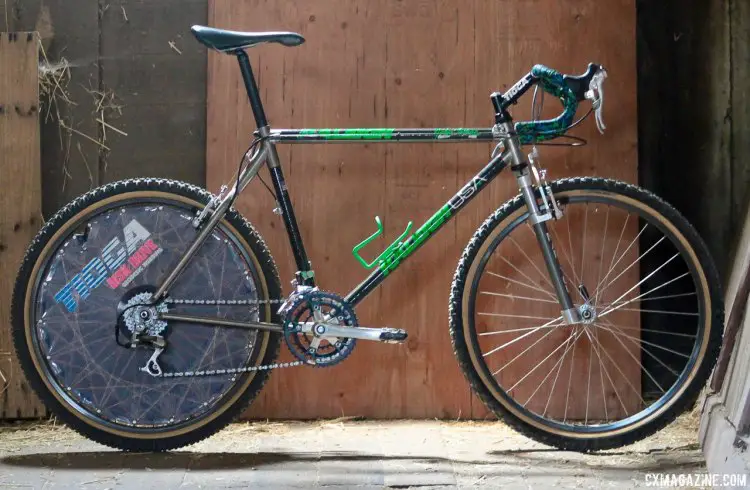
Eric Rumpf’s John Tomac replica 1991 Raleigh Signature ti/carbon drop bar mountain bike is an example of a drop bar mountain bike. © Eric Rumpf
The trend of thinking of mountain bikes with only flat and riser bars is kind of missing the history of dirt drop bars on mountain bikes. If you google “dirt drop mountain bikes,” you will find some real beauties. Salsa—with its Bell Lap, Woodchipper, Cowbell and Cowchipper handlebars—deserves credit for developing non-traditional drop bar bikes, and Brant Richards of On-One Midge fame (with help from dirt drop guru Shiggy) deserves a ton of credit for reviving dirt drops with that bar.
Going the other way, cyclocross bikes with big tires are still cyclocross bikes, and in fact, lean a bit more toward what a gravel bike is. Admittedly, I still think the term “gravel bike” is a bit silly. I liked Bruce Gordon’s term when he created the Rock ‘n Road in the 1980s: “big tire road bike.” His Rock n Road tires make great monster cross tires and are still my favorite.
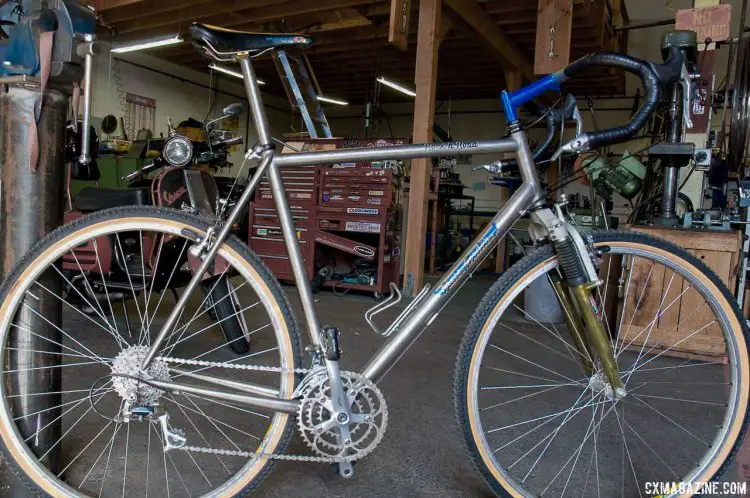
Bruce Gordon’s Rock ‘n Road is one of the early drop bar fat tire mixed terrain bikes. © K. White / Cyclocross Magazine
CXM: With the growing popularity of gravel, do-it-all bikes and adventure bikes, are there now off-the-shelf bikes that fit your definition? Which ones if so?
JS: No, not really. I think that it’s cool seeing these gravel bikes come out that are what road bikes should have been anyway. I think the adventure bike and bike packing movements are logical niches that definitely deserve to grow.
I will say Soma’s Wolverine and Surly’s Cross Check are still tough to beat for someone wanting to give monster cross a go. And a great thing is if they hate it, both frames are great for so many things. Both allow you to go custom after you spend a bit of time figuring out what you like. That’s what I did. I started with a Surly Cross Check.
From my experience, the best way to ride monster cross is to get a custom bike because it is designed to do everything and it’s the one bike you’ll have forever. Your tastes in other types of bikes might change as the market does, but a monster cross bike will always be what it is.
I do dream of one day offering a good, inexpensive frame ready to be built as a monster cross bike, but I have to find a company or distributor that believes in it. I’ve got some ideas for sure, but it’s expensive to do a batch of even inexpensive frames. I never intended to start a brand or profit from the page or my research on the topic, but then again, it has been 10 years now. I do know my stuff and I do think it’d work.
CXM: If someone wants to do a DIY build, what’s a better platform to start with? A 29er hardtail, 700c hybrid or 26” wheel mountain bike?
JS: I would exclude mountain bike frames from the start [for a true monster cross]. The cranks will always be too wide to truly get the full ride feeling and running narrower 40 to 45mm tires is not what they were designed for, so the handling will be odd.
Why? A set of even 700x40c tires will raise the bottom bracket up too much on an old 26″ hardtail. On a 29er, the geometry is designed for at least 2.0-2.2″ tires, which have larger diameters than monster cross tires, so the BB will be a bit lower and may result in pedal strikes or just won’t feel right. Mountain bikes are also designed for suspension-corrected forks and even running a rigid fork will feel a bit off in most cases. I’m not saying there aren’t exceptions, since every 29er frame is different, but in most cases, it won’t feel right.
A Low Q factor is a really important part of the monster cross ride. It’s more efficient and just heightens the feel. I’m not sure how to put it into words, but I know every time I get on my monster cross or road bike, I love the feeling.
If you want a drop bar mountain bike that can do a lot, 1990s era mountain bike frames are great. Throw on some 1990s racing semi-knob tires or Compass 26 x 2.35″ slicks and you’ll have a blast.
As silly as it sounds, a lot of old hybrid frames from the 1990s are awesome. They had 68mm BB shells, slightly sloping top tubes and room for 38-44mm wide tires for most frames. The old Trek Multitrack series from that era is a great option. If you can find an original Diamondback Overdrive or Overdrive Comp or Bianchi Project 7 frame, they were designed to fit 45mm-wide Panaracer Smokes. Those both rocked, and I actually own a Diamondback Overdrive Comp. Every now and then when I’ve had too much whiskey I think of adding S&S couplers to it.
If you are trying to find a DIY frame, I recommend building a rear wheel with your desired tire size mounted and inflated. Go to shops or Craigslist looking for frames and see if the wheel and tire fit. I recommend mounting a 38mm tire since it will likely fit most old hybrid frames. Measure the inside of the chainstays where the tire is widest to see how much more tire width you can fit.
By EU safety standards, you want 6mm of clearance on all sides, minimum. If you take the inside chainstay width and subtract 12mm, you can calculate the tire width that will safely fit. Or ignore the safety standard as you see fit, but if your tire rubs, you’ll kick yourself for not measuring twice.
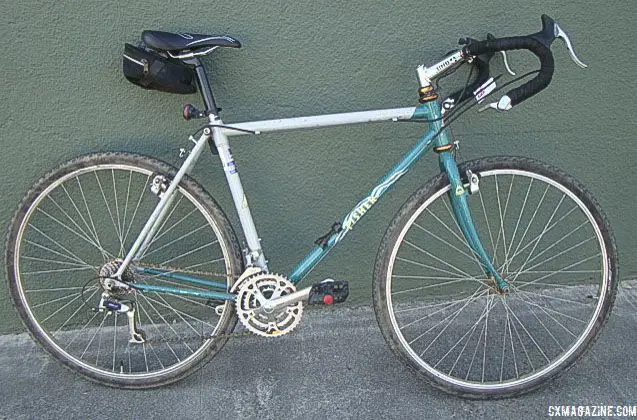
The Gary Fisher Sphinx is an example of a 1990s hybrid frame that can be used as a DIY monster cross platform. Gary Fisher Sphinx. © Steve O’Bryan
CXM: What are your thoughts on suspension on monster cross bikes? Have any opinions on the forks (Lauf, Fox), stems and posts available now?
I think you’re defeating the purpose of the monster cross concept some by adding suspension. Complicating it for what goal? I haven’t ridden either fork you mentioned, but I am curious to try both and who knows, maybe they do make sense.
The Lauf is a really neat design. I’ve love to try one, and it fits the ethos of a monster cross: simple, nothing left to add, nothing left to take away and zero maintenance. So yeah, I’d love to try that.
The Fox and MRP forks? No doubt smarter people than me made those things to be pretty awesome. But you still need to maintain them over the long run. But again, who knows. Maybe there is a place? Have to try them out down the road and see. I don’t want to discourage either, but I don’t encourage either.
Suspension posts of the past don’t really resonate with me. They always seem to develop play and need attention. Not that I’d be against trying modern options, but it’s just one more thing to work on.
That said, I do love posts designed to flex and that’s why I believe a good monster cross frame needs a sloping top tube so you can get the most out them. My favorite is a titanium post that Chris Sulfrain (now of REEB fame) made me years back. It smooths things out in a way a big tire doesn’t. I love it. I also have a Syntace carbon post designed to flex that’s lovely as well.
I’ll admit, I was a fan of the old Softride stems, but they needed attention. I know the new Redshift stems get a lot of rave reviews and are simple enough to not be a pain. I’d love to try one. Especially if they offer one with 17-25 degrees of rise.
CXM: I’ve heard you are working on your own tire, even selling some gear off to buy a mold. What’s this tire going to be like, and how does the process of making your own tire work?
JS: That dream is still alive, but I’m keeping it under wraps for now. I’ll just say it’s different than anything else in that size range that’s available right now. It’s an expensive process, but it’s going to be worth it to get the tire I want. It will happen one day, I just got word one distributor is willing to carry it, so that helps. It’s still going to take some more work before it can happen though.
CXM: We’ve both coveted high-volume 700c tires for ages, but over the last few years, a decent selection has emerged that’s both versatile and not gravel-specific. What do you find lacking with the current crop of tires that made you want to make your own?
JS: I’d still argue most of what’s being offered is still gravel-specific. Not that it’s bad; I really dig a lot of them, so I don’t want to speak bad of them. For most people they work great. Really the only non-gravel-focused tires are the Panaracer FireCross 45mm and the Ritchey Megabite 38mm, which are both really knobby tires. Otherwise, I’d say they’re all gravel tires, for the most part. For many, the current batch of tires will suffice.
Personally, I recommend either the Bruce Gordon Rock ‘n Road or Soma Cazadero as your starting point if you plan to ride singletrack and/or off-road.
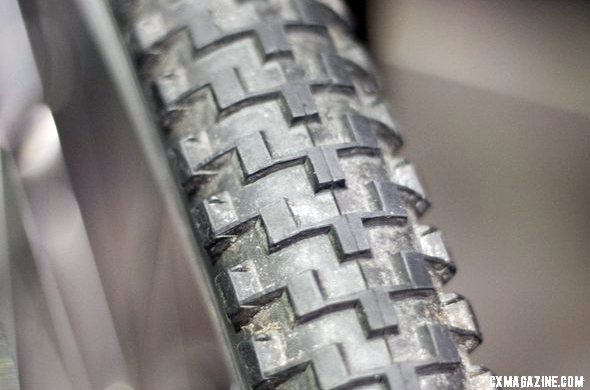
Bruce Gordon is bringing back the Rock ‘n Road Tire, a smooth-rolling oversized 700c cyclocross tire. Bruce Gordon Cycles © Cyclocross Magazine
CXM: You have strong opinions on drop bars for dirt. There’s plenty of flared bars now from companies like Easton, Ritchey, Salsa, etc. What’s the difference between a flared bar and a dirt drop bar in your opinion?
JS: I wouldn’t say it’s my opinion so much as I’m against the generalization they’re all the same, because they aren’t. It probably comes back to my background in history. I’m about accuracy so we can properly understand.
I do love the flared bars like the Cowbell and Bell Lap on cyclocross bikes I’ve owned and think they are what road bars should be, period. But in the end, a flared drop bar is still just that: a road bar. Which is fine, that’s what they are ultimately designed around and meet that need perfectly. I think it’s really awesome how many companies are jumping on board with that. They’re just not great for monster cross in my opinion, but again, monster cross is not what the designers intended them for.
Dirt drops like the Nitto RM-3, Soma Junebug/Portola, Origin 8 Gary Line, On-One Midge, Salsa Woodchipper/Cowchipper and so forth give you extra leverage and control off-road. It’s as simple as that. They’re designed to be ridden in the hooks and off-road. They’re a bit wider than most drop bars by a bit.
Personally, I wouldn’t even think of putting one of those bars on my gravel bike—yes I own one—because I use that bike on the road as well. It’s a road bike and a road type bar works best.
CXM: I’m sure you have an impressive collection of related bikes. Can you tell us about what is in the quiver?
JS: Usually it grows because I want to try something such as a different tire size or geometry or need to test something for someone. But I do purge a bit; I’m not one of the N+1 types. I try different bikes to see what they ride like, tinker with them a bit and then sell them to fund the next project.
I believe in keeping a simple quiver of bikes I’ll actually use, and it’s not uncommon for me to only have two to three bikes. Less bikes, ridden more. I’m not a fan of collecting just to collect. Even if I had the money and space, I probably would not have 20+ bikes unless each meant something. I’d rather save up $10k to one day own a Cunningham than have 10 bikes at $1,000 each. And I’d ride that Cunningham (as well as hang it as art at my home).
Right now I have the following bikes:
- Vintage Diamondback Overdrive Comp. Built up monster cross with Soma Portola bars and an old set of Magura drop bar levers and cantis. It’s a fun ride. I hunted one of these down because it was one of the first production bikes to fit 45’s.
- Singlespeed custom monster cross made by Tessier Cycles. I actually got hit by a car while riding it, and the frame is under repair as we speak. I’ve had that now eight or nine years and only recently built a new set of wheels for it with Phil Wood hubs and Velocity Quill rims.
- Be’er Plus bike. Tested a frame for a British bike designer friend, and it became my go-to mountain bike. I have it set up 27.5+ front and 26+ rear. Not what it was intended for but I love it.
- Niner RLT RDO gravel bike. I hate calling it a gravel bike, but it’s my road bike. I really just have it so I can test tires and ride with certain industry/non-industry people for work-related meetings. Otherwise, I would most likely not have one.
- Slingshot Cyclocross travel bike. Set up as my all-road bike. 1x. Canti brakes. Simple.
- New Albion Drake. Flat bar urban mountain bike ripper. It was designed for drop bars, but I saw the potential as sort of a neo-old school mountain bike.
- Kona Big Honzo B+ bike
- Titanium custom geared monster cross
CXM: Besides running Monster Cross News and helping a few bike industry clients out, what keeps you busy?
JS: Monster Cross News has always just been a hobby. I majored in history, so it’s my outlet for that. It’s my historical preservation project.
I also founded a nonprofit called the Urban Singletrack Project six years ago, and four years ago it became official thanks to the CAN’d Aid Foundation, which is Oskar Blues Brewery’s foundation. The goal of the program is to get more people outside and learning to ride on dirt.
I also organize Sports & Recreation Expos in Colorado Springs and promo events for restaurants and bars. I also do some non-bike industry small biz consulting, which I love even though the pay is low. I’ve also recently partnered with a company that helps pair brands with sports-based influencer marketing opportunities. I primarily deal with Olympic athletes, which I enjoy because we actually get them paid well, which is something most NGOs don’t do.
So in short, I am a contractor.
CXM: Sounds like you are busy! Thanks for your time, and we look forward to continuing to follow Monster Cross News.
JS: Thank you. This was fun.













